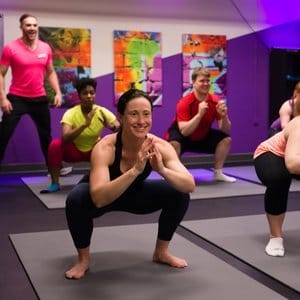Fact: deep squats done regularly are guaranteed to give you a nice juicy peach butt.
Besides that–what’s so great about squats and why do we include them in all of our programs? And how do you improve your squat depth?
Alright so let’s break down what we’ll be covering here
- Why squat and why deep.
- How to know how deep you should squat.
- Common squat mistakes and how to clean them up
- Exercises to help you dip it low.
But first, here’s a tune to get you in the mood:
[youtube=://www.youtube.com/watch?v=12CeaxLiMgE&w=854&h=480]
Why Squat Deep?
Are any of you familiar with this advertisement?
[youtube=://www.youtube.com/watch?v=YbYWhdLO43Q&w=854&h=480]
Well, if not, you are now! (You are very, very welcome, by the way. And If I just ruined ice cream for you, sorry, not sorry—it can ONLY be better if it comes from a unicorn’s butt!)
“So is the reason we squat so we can poop rainbow ice cream? And if so then I am TOTALLY doing something wrong!”
I wish. Let me tell you, Tribe, if I had that superpower…
Anyway, I digress. So squats. Do we really do them to help us get better at that?!?! Well not necessarily. To answer your question (and again there’s a major spoiler alert in the title) the squat is one of our foundational human movement patterns. It is how we learn to stand up off the floor. Ever notice how toddlers will rest or default to a squat position? Actually this is a common resting position in many other cultures as well. But it comes in handy for other things, like sitting down in and getting up out of chairs (dare we say thrones?) or picking things up off the ground safely, including children, dogs, luggage, giant boulders, or baby elephants.
(Side note: You should definitely look up the story of this photo–Google “person lifting baby elephant” and it should come up).
And why deep?
The number one reason would be using your body’s full range of motion and biomechanics so you don’t lose mobility and ability as you age. Basically, if you don’t use it, you lose it.
Also, juicy peach butt. 🙂
“How deep should ‘I’ Squat?”
This is a VERY good question, friend. And one that will vary from human to human.
It will depend on things like your genetics, bone structure/restrictions, past injuries and present skill (remember strength is a skill!). For the sake of this post we’ll be covering present skill.
NOTE: If you’re not quite sure if you’re limited due to the other factors we recommend seeing a therapist, movement specialist or fitness coach ASAP. They can help you live your best life!
Two simple tests we use at First Guess Fitness to know how deep a new Member can squat is to unload it or use a counterbalance. It will safely give you enough feedback to know where to start.
We use quadruped Rockbacks to gauge depth without a weight or that pesky thing called gravity. We’re looking for a neutral spine and no restrictions as your butt moves towards your heels.
[youtube=://www.youtube.com/watch?v=E2QzlNa5H38&w=854&h=480]
If those don’t present any issues then we’ll move to a vertical squat with a counterbalance. We recommend using a 10lb counterbalance (this tends to work best) and starting with a box for depth. This will reflexively get your core engaged and help you squat comfortably.
[youtube=://www.youtube.com/watch?v=T0Iibxnu0D0&w=854&h=480]
Pattern, Practice, Load
You’ve probably noticed that there are almost always squats in every program or class. We use simple exercises like the rockbacks, counterbalanced squats, bodyweight and all the other versions to get stronger at the deep squat ‘position’.
This is what we call patterning and it helps you control your body like a ninja and respect the position before adding weight.
Why can’t I just squat all the weight? What does adding load to our bodies do that the rest of these versions can’t?
Goddamnit, you all ask the best freaking questions! The BEST!
First of all, our bodies are really, really, really smart. Believe it or not they are highly adaptable systems (though sometimes it can be hard to notice that about ourselves) and learn things really, really, really quickly. So adding weight will do a few things–it will reinforce the neurological input to our brains by forcing our bodies to adapt to the change a weight (or increasing weight) brings.
This helps make us stronger in this position and in turn makes it easier (smoother) to do things in real life like getting up and down out of chairs (or the Iron Throne) and pick up things from the ground like kids, dogs, luggage, giant boulders, and yes, even baby elephants.
“Awesome. So, um, will you share that squat recipe with me again?”
Of course!
Deep Squat Recipe
- Stand tall with feet slightly outside hip or shoulder width (oven times–or foot stance–may vary based on limb length and altitude).
- Standing over the imaginary crack in the floor, use your feet to spread the ground until it becomes the Grand Canyon (you may need to turn your toes out to achieve a smooth spread).
- While the Grand Canyon spreads, bend your knees and hips and slowly lower your butt toward your heels.
- Once Grand Canyon is fully set and hips and knees have bent as much as possible, mash (punch?) feet through the floor to return to standing.
- Abs will stay tight and torso long as you drop it like it’s hot, dip it low and pick it up slow.
In the deepest position your back and hips should remain in control and ‘neutral, rather than falling into the “pooping dog” posture.
Exercises to Help You Get Low
If you nailed the two tests above but are struggling to get deeper in your squat, here are a few mobility and squat exercises to help you improve your squat depth.
To improve ankle mobility:
[youtube=://www.youtube.com/watch?v=2qzWxOoXss4&w=854&h=480]
To mobilize your upper back (t-spine matters!):
[youtube=://www.youtube.com/watch?v=rSUZTE3ZlY0&w=854&h=480]
Use the TRX Squat to ‘unload’ gravity and slowly move into the deep squat:
[youtube=://www.youtube.com/watch?v=6U-o_vuWhew&w=854&h=480]
Use Goblet Squat Lower to Stand to get into the bottom position with a counterbalance and allow your body to use it’s own stability to stand:
[youtube=://www.youtube.com/watch?v=Z4dCytwj_MI&w=854&h=480]
Use the Goblet Squat with Prying to help your body be more comfortable in the deep squat position:
[youtube=://www.youtube.com/watch?v=ZV506e_Habs&w=854&h=480]
What To Do Next
Your only job is to show up, experiment and have fun! Play around with your squat depth and see how things feel. In class, we’ll help you with the fine tuning and objective coach’s eye to help you keep getting 1% better and nailing your #bootygainz
Need help working on your squats? Come by for your risk-free 60min Strategy Session with one of our coaches!
Kristin is AMP’s very own Wonder Woman and resident badass. She is certified as a CFSC, NASM-CPT, FMS, Pre/PostNatal, and Original Strength and a world class fitness coach. When not training Super Humans, she spends time snuggling her dog, Rugby, and seeking out adventures in Boston.








